Volume. 1, July - September, 2012 - amam-ayurveda.org
Volume. 1, July - September, 2012 - amam-ayurveda.org
Volume. 1, July - September, 2012 - amam-ayurveda.org
Create successful ePaper yourself
Turn your PDF publications into a flip-book with our unique Google optimized e-Paper software.
Table 1: Pattern of Improvement in the subjects with increased duration<br />
of cycles<br />
Duration Baseline Cycle<br />
1<br />
(>32 days)<br />
Increased<br />
cycles<br />
Mean 46.15<br />
(n=26)<br />
35.03<br />
(n=26)<br />
Cycle 2 Cycle<br />
3<br />
35.65<br />
(n=26)<br />
30.45<br />
(n=22)<br />
± 18.9 ± 9.72 ± 7.82 ± 4.04<br />
Mean<br />
Change<br />
Info Ayurveda, <strong>Volume</strong> 2, No.1, <strong>July</strong> to <strong>September</strong>’ <strong>2012</strong><br />
%<br />
reduction<br />
15.7 34.01<br />
4.1.2. Effect of WHS on decreased duration of cycles (n=5):<br />
In subjects reporting with decreased duration of cycles (n=5), mean<br />
duration was 17.80 (+ 03.97) days at baseline. After intervention<br />
with the trial drug, all the subjects (100%) have achieved near normal<br />
duration of cycles by the end of fourth cycle with a mean duration of<br />
23.60 (+ 07.16) days. Mean change was 05.80 days i.e., 32.58% increase<br />
in duration of cycle with P32 days)<br />
Increased<br />
cycles<br />
Mean 17.80<br />
(n=5)<br />
22.60<br />
(n=5)<br />
Cycle<br />
2<br />
23.00<br />
(n=5)<br />
Cycle<br />
3<br />
22.20<br />
(n=5)<br />
Cycle<br />
4<br />
23.60<br />
(n=5)<br />
SD ±3.97 ±3.43 ±2.73 ±4.49 ±7.16<br />
4.2. Effect of trial drug on irregular bleeding days<br />
Mean<br />
Change<br />
%<br />
reduction<br />
5.8 32.58<br />
4.2.1. Effect on increased bleeding days (n=11):<br />
After the intervention with the trial drug none of the subjects shown<br />
normal bleeding days by the 3rd cycle. Only 4 subjects (36.67%) have<br />
shown normal bleeding days pattern during the 4th cycle. The mean<br />
number of days of improvement was 0.97 days i.e., a percentage reduction<br />
of 14.43% with P>0.05<br />
Table 3: Effect of trial drug in subjects with increased bleeding days<br />
Duration Baseline Cycle<br />
1<br />
(>32 days)<br />
Increased<br />
cycles<br />
Mean 03.75<br />
(n=8)<br />
04.25<br />
(n=8)<br />
Cycle<br />
2<br />
04.25<br />
(n=8)<br />
Cycle<br />
3<br />
04.13<br />
(n=8)<br />
Cycle<br />
4<br />
04.20<br />
(n=5)<br />
SD ± 0.7 ± 1.4 ± 1.3 ± 0.9 ± 0.8<br />
Mean<br />
Change<br />
%<br />
reduction<br />
0.45 12.00%<br />
4.2.2. Effect on decreased bleeding days (n=8):<br />
After the intervention with the trial drug all the subjects have shown<br />
normal bleeding days by the 3rd cycle (4.2 days + 0.90). The mean number<br />
of increase in bleeding days was 0.45 days i.e., a percentage increase of<br />
12.00% with P>0.05.<br />
Table 4: Effect of trial drug in subjects with decreased bleeding days<br />
Duration Baseline Cycle 1 Cycle<br />
2<br />
( > 3 2<br />
days)<br />
Increased<br />
cycles<br />
Mean 17.80<br />
(n=5)<br />
22.60<br />
(n=5)<br />
23.00<br />
(n=5)<br />
Cycle<br />
3<br />
22.20<br />
(n=5)<br />
Cycle<br />
4<br />
23.60<br />
(n=5)<br />
SD ±3.97 ±3.43 ±2.73 ±4.49 ±7.16<br />
Mean<br />
Change<br />
%<br />
reduction<br />
5.8 32.58<br />
4.2.3. Effect of Trial drug on number of pads (increased duration of<br />
cycles): (n=26)<br />
The reduction in number of pads in case of subjects having increased<br />
duration of cycles was 21.4 at baseline against 19.4 at the end of 4th<br />
cycle.<br />
Table 5: Efficacy of WHS on no. of pads in increased duration of cycles<br />
Baseline<br />
(n=26)<br />
cycle 1<br />
(n=26)<br />
Cycle 2<br />
(n=26)<br />
Cycle 3<br />
(n=22)<br />
No. of pads 21.4 24.42 26.5 23.4 19.4<br />
Cycle 4 (n=5)<br />
4.2.4. Effect of trial drug on number of pads (decreased duration of<br />
cycle): (n=5)<br />
There was an increase in number of pads in case of subjects having<br />
decreased duration of cycles viz., 16.3 at baseline against 21.4 at the end<br />
of 4th cycle.<br />
Table 6: Efficacy of WHS on no. of pads in decreased duration of cycles<br />
No. of<br />
pads<br />
Baseline<br />
(n=5)<br />
cycle 1<br />
(n=5)<br />
Cycle 2<br />
(n=5)<br />
Cycle 3<br />
(n=5)<br />
Cycle<br />
4<br />
(n=5)<br />
Cycle 5<br />
(n=5)<br />
16.3 21.1 19.8 23.1 21.4 28.75<br />
4.2.5. Effect of trial drug on menstrual flow (increased duration of<br />
Cycle): (n=26)<br />
Among 26 subjects in the increased duration of cycle, there were 9 with<br />
heavy flow and 8 with scanty flow. Remaining 9 subjects presented with<br />
moderate (normal) flow. In the heavy flow category only one subject was<br />
left with heavy bleeding by 3rd cycle. Among the scanty flow category 2<br />
were left with scanty flow by 3rd cycle.<br />
Table 7: Efficacy of WHS on amount of flow in increased duration of<br />
cycles<br />
Flow Baseline cycle 1 Cycle 2 Cycle 3 Cycle 4<br />
Heavy 9 7 2 2<br />
Moderate 9 14 19 19 5<br />
Scanty 8 5 5 2<br />
4.2.6. Effect of trial drug on menstrual flow (decreased duration of<br />
Cycle): (n=5)<br />
In case of decreased duration of cycles, 2 had heavy flow and 3 had<br />
moderate (normal) flow. By 4th cycle all the subjects have fallen under<br />
the moderate flow category.<br />
Table 8: Efficacy of WHS on amount of flow in decreased duration of<br />
cycles<br />
Flow Baseline cycle 1 Cycle 2 Cycle 3 Cycle 4 Cycle 5<br />
Heavy 2 1 1 1 0 0<br />
Moderate 3 4 4 4 5 2<br />
Scanty 0 0 0 0 0 0<br />
13


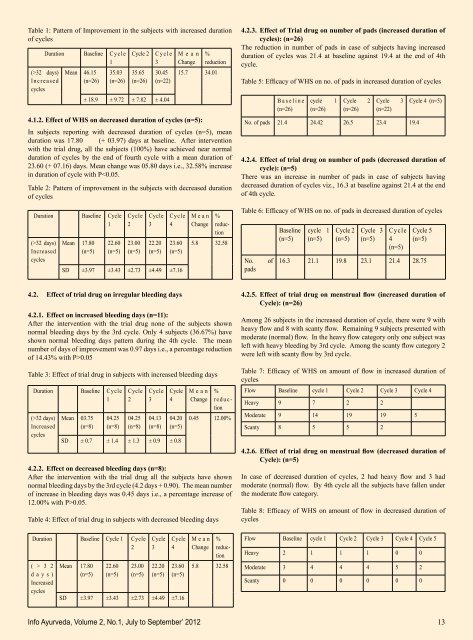

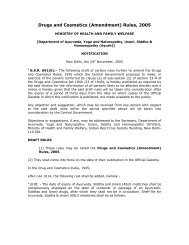
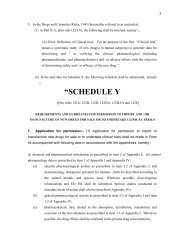
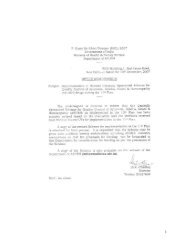




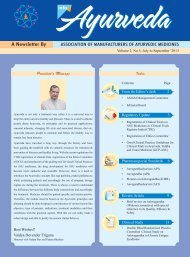
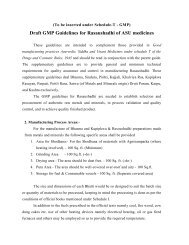

![[To be published in Gazette of India Part II Section 3, sub-section iii]](https://img.yumpu.com/28570283/1/190x245/to-be-published-in-gazette-of-india-part-ii-section-3-sub-section-iii.jpg?quality=85)

